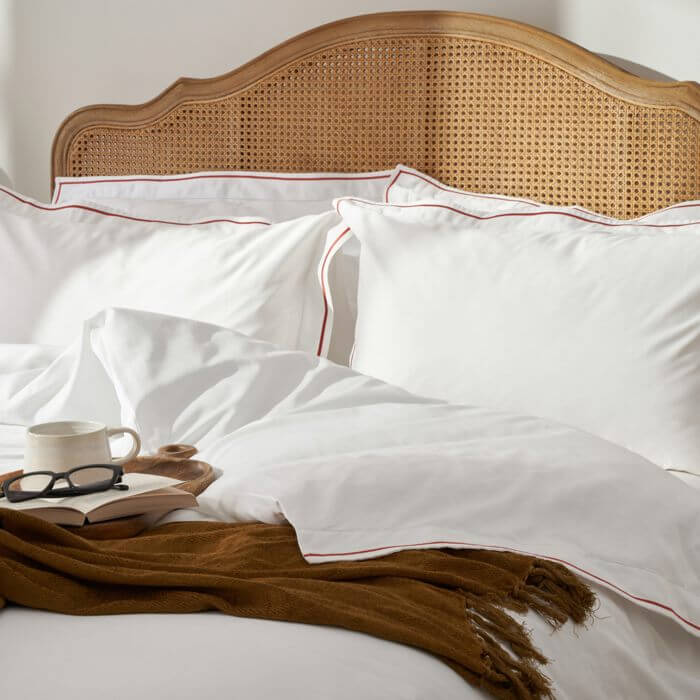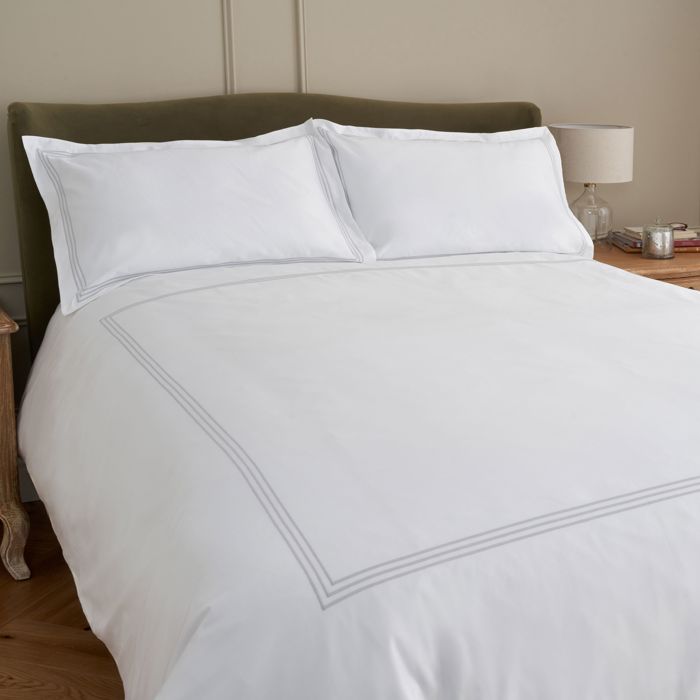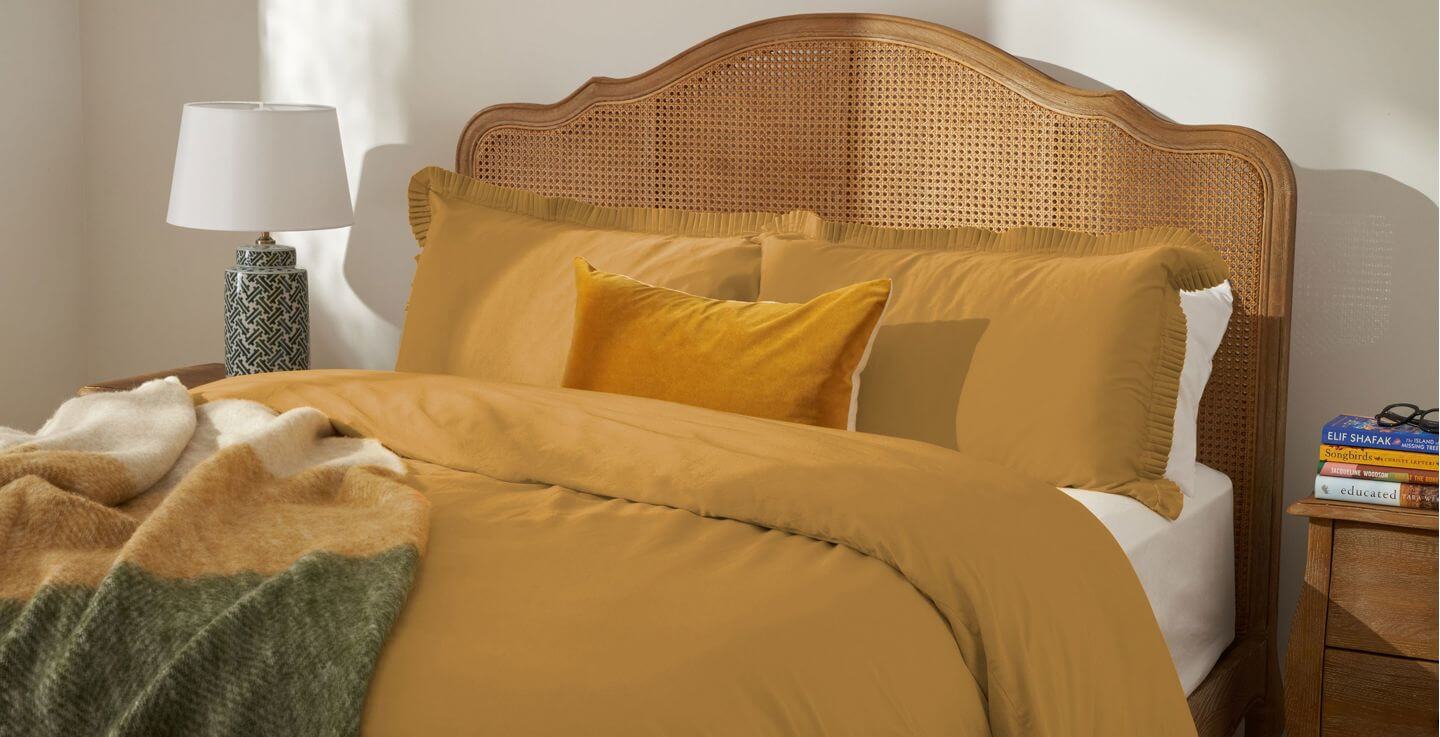Bed Linen Guide
There’s a quiet luxury in the ritual of making your bed. The gentle weight of a well-draped duvet, the crisp fold of a freshly washed bed sheet, the soft rustle of natural fibres as you settle in for the night.
Allow us to guide you through the best bed linen for your lifestyle, sleep and bedroom space. From fabric composition and weave to temperature regulation and styling, we’ll walk you through the finer details that truly make all the difference.
Which fabric is suitable for you?
The fabric you sleep in is as important as the mattress beneath you. It touches your skin for hours each night, regulates your body temperature, and influences how restful your sleep truly is. Choosing the right bed linen isn’t just a matter of style; it’s a decision that shapes your sleep.
Cotton: The refined everyday
Cotton has long been the foundation of good-quality bed linen, and with good reason. Naturally breathable and wonderfully resilient, it offers a balance of softness and strength that suits everyday use. Combed cotton, in particular, is prized for its smooth finish; the fibres are carefully refined to remove shorter threads, resulting in a fabric that feels luxuriously soft from the very first night and only improves with time.
While a thread count of 180 or more is often seen as a hallmark of quality, it’s only part of the story. The true comfort of cotton lies in the calibre of its fibres, the precision of its weave, and the finesse of its finish. For those seeking a refined sleep experience, our 400 thread count cotton collection offers a beautifully balanced feel, while the 600 thread count range delivers an even silkier, more indulgent touch.

Linen: Naturally intelligent
Linen, derived from the flax plant, is a fibre of quiet sophistication. It’s inherently breathable, moisture-wicking, and thermoregulating, keeping you cool in summer and comfortably cocooned in winter. It’s the best bedding material for hot sleepers and those seeking the coolest bedding. Its texture, slightly more open than cotton, offers a relaxed, tactile quality that softens beautifully with every wash, adding to its timeless appeal.
Explore our guide to sleeping in hot weather for more tips on staying cool at night.
Cotton-linen blends: Balanced beauty
Blending cotton and linen creates a fabric that’s both structured and breathable, soft yet textured. These blends are ideal for those seeking the best bedding material for year-round use, offering the crispness of cotton with the breathability of linen. They also tend to wrinkle less than pure linen, making them a practical yet elegant option.
Silk: The indulgent touch
Silk is the pinnacle of luxury bed linen. Spun from the cocoon of the silkworm, it’s naturally hypoallergenic and incredibly smooth, making it ideal for sensitive skin. Its insulating properties help regulate temperature, while its lustrous finish adds a subtle glow to your bedroom.
However, silk requires care. It’s delicate, prone to water spots, and best washed by hand or on a gentle cycle. For those who value indulgence and are willing to nurture it, silk offers a sleep experience like no other.

Flat vs fitted sheets: Finding your perfect fit
In the world of bed linen, the choice between flat and fitted sheets is a subtle yet meaningful detail - one that reflects your personal rituals and the way you find comfort at day’s end. Both bring their own elegance and practicality, each playing a distinct role in the art of dressing a beautiful bed.
Fitted sheets: Tailored ease
Fitted sheets are the go-to for effortless precision. With elasticated corners that gently grip your mattress, they create a smooth, secure base that stays in place night after night. Ideal for those who favour a streamlined routine, fitted sheets make bed-making refreshingly simple.
Flat sheets: Understated versatility
A flat sheet is a large, rectangular layer of fabric that offers elegance and adaptability. Traditionally placed between you and the duvet, it creates a polished, hotel-style finish to your bed while adding an extra layer of comfort.
It can also be used as a lightweight cover in its own right - perfect for warmer nights when a duvet feels too heavy. Whether layered beneath or draped over, it brings a sense of softness and refinement to your sleep space.
Understanding bed sheet depths
Not all mattresses are created equal, and neither are bed sheets. Deep mattresses, especially those with toppers or pillow tops, require sheets with extra depth to stay securely in place.
- Standard Depth (25–30cm): Suitable for most mattresses without toppers.
- Deep Fit (30–38cm): Ideal for deeper mattresses or those with a topper.
- Extra Deep (up to 40cm+): Best for very plush or layered mattresses.
We recommend measuring your mattress height before purchasing to ensure your fitted sheet will not come off during the night. A well-fitted sheet not only looks tidier but also improves your comfort.
Understanding pillowcase styles & sizes
Choosing the right pillowcase goes beyond size. It’s a thoughtful decision about style, structure, and how you want your bedroom bedding to feel and look.
Standard housewife pillowcases (50cm x 75cm)
The most common pillowcase style, this rectangular shape fits standard pillows and features a clean, edge-to-edge design with no border - simple, neat, and timeless.
Oxford pillowcases (50cm x 75cm)
The same size as a Housewife, but with a decorative border (known as an Oxford edge) that adds a touch of refinement. Perfect for layering and adding visual interest.
Super king pillowcases (50cm x 90cm)
Slightly longer in length, these pillowcases are designed to suit King and Super King beds, helping to eliminate the gap between pillows. Offered in housewife and Oxford pillow styles, they offer a refined, tailored finish for larger sleep spaces.
Continental pillowcases (65cm x 65cm)
Square in shape, these are often used as back pillows against the headboard. Available in housewife and Oxford styles, they add structure and elegance to your bedscape.
Layering tips for a beautifully styled bed
Styling a bed is both an art and a science. It involves creating a space that feels personal, polished, and truly restful. At Feather & Black, we believe that the best styling begins with thoughtful layering and a keen eye for texture to enhance your bedroom decor.
The all-white bed
A bed dressed entirely in white is timeless. But the secret to making it feel luxurious rather than clinical lies in the mix of materials. Combine crisp percale sheets with a soft sateen duvet and a linen throw to add depth and dimension. Subtle embroidery or a tonal border, like those on our Cotton Ladder Stitch Bed Linen Set, brings texture without disrupting the calm.
Dressing a guest bed with grace
A guest bed should feel like a warm welcome. Opt for soft, romantic touches such as the Cotton Collection Frill Bed Linen Set, with its delicate frilled edging. Pair with Oxford pillowcases for added elegance, and finish with a velvet or bouclé throw and a few scatter cushions in complementary tones. These thoughtful layers create a sense of quiet luxury that your guests will truly appreciate.
Indulge in timeless comfort with Feather & Black’s bed linen
Discover our luxury bed linen collection and create a sleep space that blends timeless style with exceptional comfort. From beautifully crafted sheets to finishing touches that elevate your bedroom, explore pieces designed to enhance every night’s rest.
